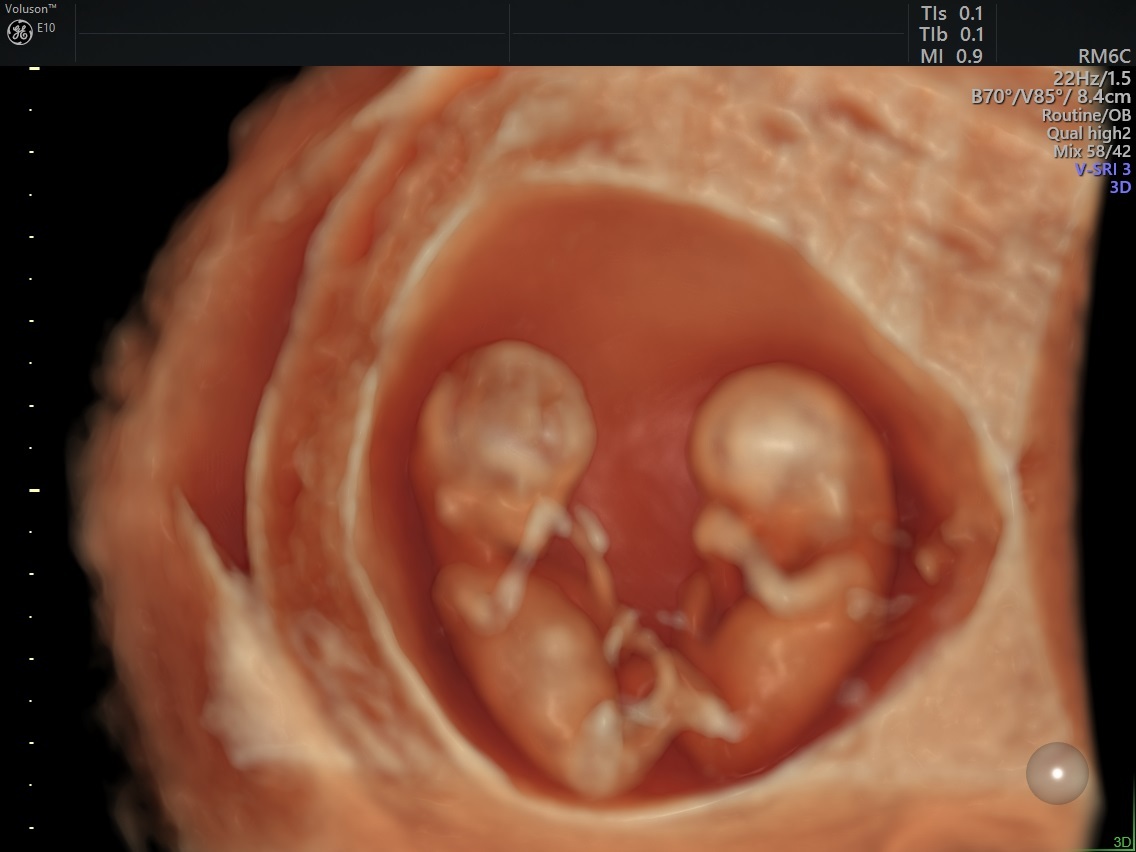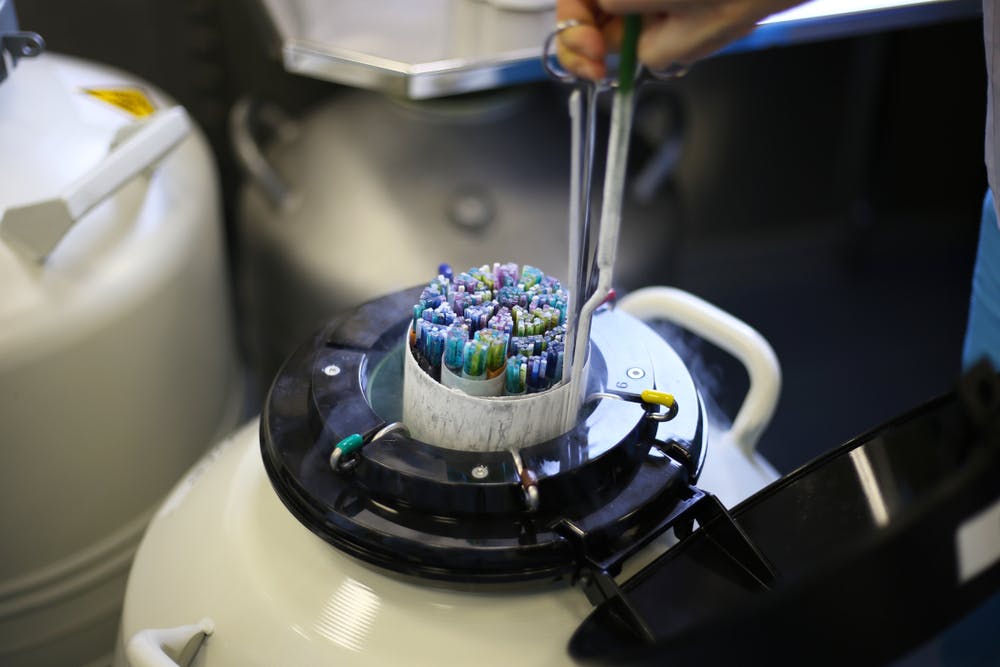Twenty years ago, a study published in the Journal of the American Medical Association analyzed 35,554 IVF cycles and the resulting 9,873 live births to determine the ideal number of embryos to transfer by age. Women between 20 and 34 years old had the most live births when transferring two embryos and cryopreserving any remaining embryos. Live birth rates were lower overall for women 35 and older, but the maximum IVF success rate was achieved by transferring more than two embryos.

3D HDlive Ultrasound Image of 12 Week Twins
In this study, multiple birth rates were 22.7 percent for women aged 20 to 29 and 10.8 percent for women aged 40 to 44. Multiple births increased dramatically for younger women when transferring three embryos — 45.7 percent for women between 20 and 29 and 39.8 percent for women between 30 and 34. Even when transferring five or more embryos, the multiple birth rate was less than 25 percent for women ages 40 to 44.
Today's IVF labs are far more advanced than in the past, and the procedure is no longer experimental. Its very success increases the likelihood of multiple births for multiple transfers. Both elective single embryo transfer (eSET) and multiple embryo transfer (MET) procedures continue to be available, but MET is being recommended less often as more research comes to light.
Risks of Conceiving Twins and Other Multiples
Part of the controversy over single versus multiple embryo transfer comes from the risks of a multiple pregnancy. Even twenty years ago, the chance of conceiving multiples was mitigated as much as possible because of possible complications such as anemia, intensified morning sickness, pruritic urticarial papules and plaques of pregnancy (PUPPP), hyperemesis gravidarum and gestational diabetes.
Meanwhile, twins and other multiple fetuses are at a greater risk for intrauterine growth restriction, low birth weight, premature birth and twin-twin transfusion syndrome (TTTS).
IVF Success Rate With Elective Single Embryo Transfers
The primary goal of transferring just one of a patient's available embryos is to implant a single healthy pregnancy. Preliminary data from the Society for Assisted Reproductive Technology (SART) that reports the mean number of embryos transferred per cycle by age reveals that women who are younger than 35 implant an average of 1.3 embryos. This mean gradually increases to a high of 2.2 for women who are 42 and older.
Individual clinics may see a higher IVF success rate, but according to the national SART data from 2017, the percentage of live births per cycle was:
This measurement reports the percentage of live births resulting from a single egg retrieval cycle. Singleton births made up more than 86 percent of live births for all age groups.
IVF Success Rate With Multiple Embryo Transfer
MET is when a patient has two or more embryos transferred, sometimes against their reproductive endocrinologist's recommendation. The percentage of live births when transferring multiple embryos, according to SART's 2017 data, was:
MET is less successful than eSET in achieving live births. This is especially true when the embryos transferred are of varying quality. Data presented at the British Fertility Society's 2017 annual conference analyzed 1,472 single and double blastocyst transfers and found that when one good quality embryo and one poor quality embryo were transferred, patients had a 27 percent lower chance of a live birth compared to a single embryo transfer. MET is also more likely than eSET to result in twins and higher-order multiples.
Clinical Guidance from ASRM and ESHRE
Based on SART data available through 2014, a practice committee from the American Society for Reproductive Medicine (ASRM) released a committee opinion in Fertility and Sterility in April 2017 about its recommendation regarding the number of embryos transferred per cycle. ASRM based its recommendations on a patient's age and prognosis, whether the embryo is cleavage-stage or a blastocyst and preimplantation genetic testing results.
Regardless of age and whether the embryo is cleavage-stage or a blastocyst, if it is euploid, ASRM recommends a single embryo transfer; the same goes for if the patient's prognosis is favorable but the ploidy status of the embryo is unknown. A multiple embryo transfer is recommended for patients ages 38 and up, regardless of the embryo's stage. The European Society of Human Reproduction and Embryology (ESHRE) and the UK National Health Service (NHS) recommend single embryo transfers.
Leaders in the reproductive medicine field recommend a multiple embryo transfer in very few situations. However, it's important to note that these are just guidelines — not hard-and-fast rules or laws. Ultimately, this is a decision made between patient and physician, typically with the patient's preference holding more weight. Most decisions are driven by the perceived higher success rate of multiple embryo transfers, as well as financial constraints prohibiting more than one transfer.
What Recent Research Says
Twenty years is a lifetime when it comes to scientific advancements, and clinical recommendations have changed dramatically from the early days of IVF. A study published in Fertility and Sterility based on IVF cycles performed between 2010 and 2016 examined patient groups who had undergone five different transfer scenarios to determine the success of single versus multiple transfers:
The IVF success rate for a double embryo transfer with one top quality embryo and one poor quality embryo was similar to a single embryo transfer with a top quality embryo, regardless of whether the embryo was fresh (26.5 percent versus 33.7 percent) or frozen (24.2 percent versus 32.7 percent). However, multiple births were higher for both fresh (19 percent versus 4.7 percent) and frozen cycles (10.3 percent versus 2.6 percent).
The authors conclude that live birth rate does not increase when a poor quality embryo is transferred with a top quality embryo. However, this type of double embryo transfer does increase the likelihood of conceiving multiples. Perhaps most importantly, the live birth rate when transferring two top-quality embryos was similar to transferring just one top quality embryo.
Other recent research draws the same conclusion. For example, a study published in the Journal of Assisted Reproduction and Genetics in March 2019 studied frozen embryo transfers performed between 2011 and 2017 and examined patients in four different situations after they chose either eSET or elective double embryo transfer (eDET):
Across the patient groups, live birth rates were similar. However, the patients who opted for eDET had significantly higher instances of multiple pregnancies.
The opinion of the reproductive medicine community on the IVF success rate of eSET versus MET has evolved significantly over the years. However, there is a definitive consensus that eSET is strongly recommended in most scenarios. As IVF labs continue to improve and patients become more educated about each of these methods, eSET likely will become even more prevalent.


